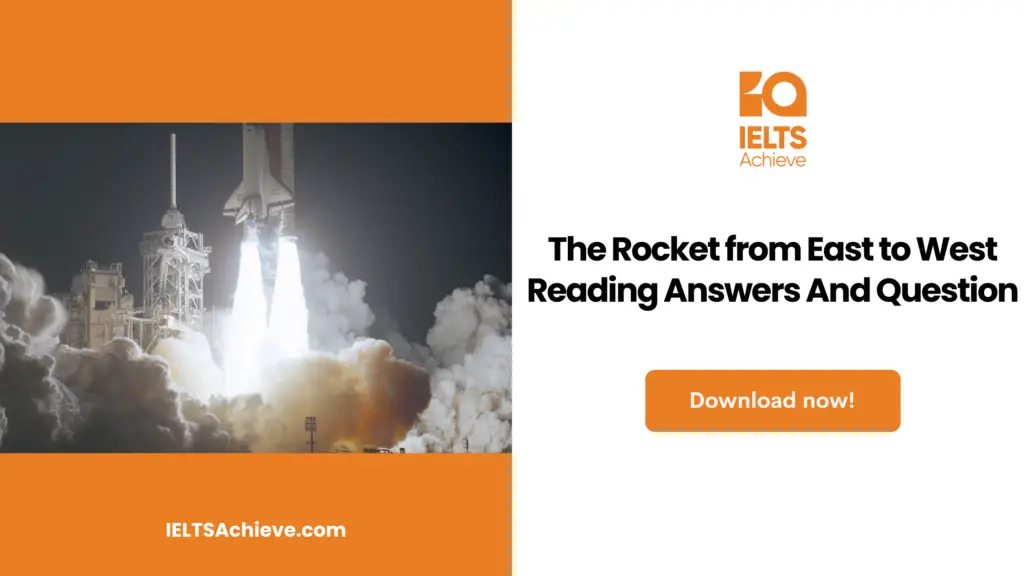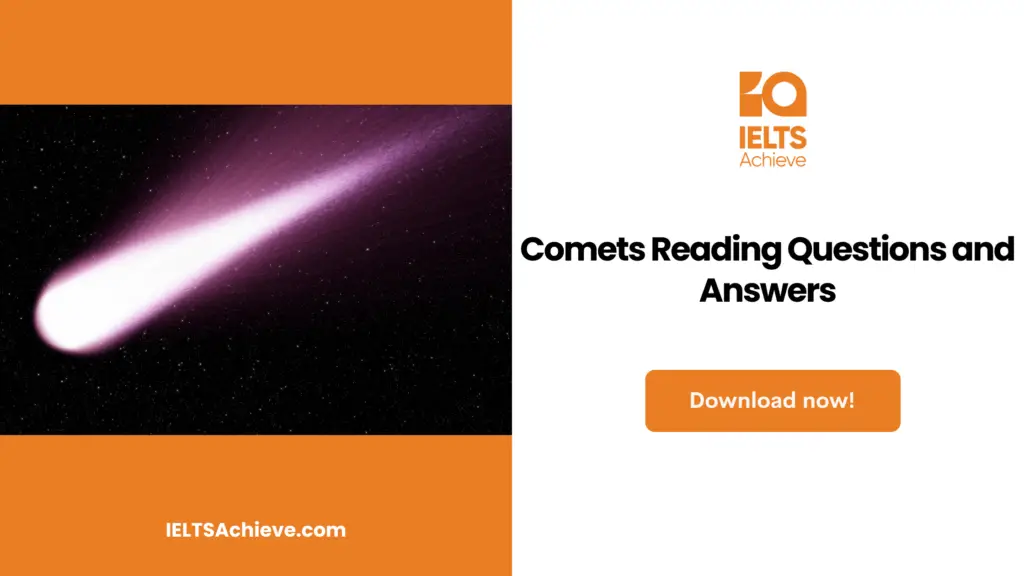The Blog post contains the following IELTS Reading Questions:
- IELTS Reading Matching Headings
- IELTS Reading Locating Information
- IELTS Reading Multiple Choice Questions
- IElTS Reading Diagram Labelling
Stay informed and prepared for success – Explore our comprehensive Reading Test Info page to get valuable insights, exam format details, and expert tips for mastering the IELTS Reading section.
The Rocket from East to West IELTS Reading Passage

The Rocket – from East to West
A. The basic principle of the rocket, or preferably the apparatus behind the notion of moving an object into the air, has been around for well over 2 millennium years. Nevertheless, it wasn’t till the finding of the reaction principle, which was the opener for space travel and so represents one of the immense milestones in the history of scientific concept, that rocket technology was able to expand. Not only did it conclude an issue that had interested man for ages, but, more essential, it opened the door to study of the universe.
B. An intellectual advancement, luminous though it may be, does not spontaneously make sure that the change is made from theory to practice. Notwithstanding the fact that rockets had been used occasionally for a few hundred folds, they dwelled a comparatively minor artifact of civilization till the 20th century. Colossal attempts, accelerated throughout two world wars, were needed before the technology of ancient rocket engineers could be translated into the actuality of worldly cosmonauts. It is unfamiliar that the rocket was normally disregarded by writers of novels to transport their heroes to puzzling kingdoms beyond the Earth, yet it has been often used in fireworks displays in China since the 13th century. The reaction principle with the notion of traveling through space to a nearest world.
C. Through an analogy, we can realize how a rocket works. It is much like a machine gun ascend on the back of the boat. In response to the reverse discharge of bullets, the gun, and hence the boat, move ahead. A rocket motor’s ‘bullets’ are tiny, high-speed specks manufactured by flaming propellants in an acceptable room. The response to the emission of these tiny specks causes the rocket to move ahead. There is proof that the reaction truth was appealed almost well before the rocket was innovated. In his Noctes Atticae or Greek Nights, Aulus Gellius explained ‘the squab of Archyats’, an innovation dating back to about 360 BC. Cylindrical in shape, made of wood, and hanging from twine, it was passed to and away by water vapor blowing out from the tiny exhaust boatyard at either conclusion. The reaction to the discharging stem provided the bird with power of motive.
D. The innovation of rockets is connected indistinguishably with the innovation of ‘black powder’. Most chroniclers of automation credit the Chinese with its discovery. They foundation their faith on studies of Chinese writings or on the notepad of early Europeans who sortout in or made wide visits to China to study its chronicle and advancement. It is likely that, some time in the 10th century, black powder was first aggravated from its origin components of nitre, carbon and brimstone. But this does not mean that it was instantly used to move rockets. By the 13th century, powder-moved fire shafts had become rather normal. The Chinese depend on this type of automation growth to manufacture combustible missiles of many kinds of device ammunition and perhaps cannons to repulse their opponent. One such shield was the ‘basket of fire’ or, as straightly translated from Chinese, the ‘arrows like flying leopards’. The 0.7 meter-long shaft, each with a lengthy tube of blackpower fixed near the point of each shaft, could be fired from a lengthy octadic-shaped basket at the same time had a span of 400 paces. One more shield was the ‘arrow as a flying saber’, which could be fired from ammunition. The rocket, spotted in a alike location to other rocket-moved shafts, was planned to increase the span. A tiny iron weight was connected to the 1.5m bamboo arrow, just beneath the feathers, to improve the shaft’s firmness by propelling the middle of gravity to a position beneath the rocket. At the same time, the Arabs had expanded the ‘egg which moves and burns’. This ‘egg’ was seemingly full of black powder and balanced by a 1.5m tail. It was fired using two rockets fixed to either side of the back end.
E. It was not till the 18th century that Europe became solemnly attentive in the chance of utilizing the rocket itself as a shield of war and not just to move other shields. Earlier to this, rockets were used only in fireworks displays. The inducement for the more hostile use to rockets came not from inside the European continent but from distant India, whose heads had built up a corps of astronauts and used rockets profitably opposed to the British in the late 18th century. The Indian rockets used against the British were narrated by a British commander serving in India as ‘an iron wrapper about 200 millimeters long and 40 millimeters in width with sharp tip at the top and a 3m-lengthy bamboo leading stick’. In the early 19th century the British started to test with combustible bombardment rockets. The British rocket varied from the Indian version in that it was totally framed in a stout, iron cylinder, ending in a conical head, measuring one meter in width and having a twig almost five meters lengthy and built in such a way that it could be firmly fond of to the body of the rocket. The Americans improved a rocket, entirely with its own bombarder, to use opposed to the Mexicans in the mid-19th century. A lengthy cylindrical tube was buttressed up by two twigs and locked to the top of the launcher, thereby permitting the rockets to be inserted and set alight from the other end. However, the solutions were occasionally not impressive as the conduct of the rockets in aviation was less than foreseeable.
F. Later, there has been enormous enlargement in rocket technology, frequently with destructive outcomes in the forum of war. However, the present day space programs owe their achievement to the respectful origination of those in preceding centennial who expanded the base of the reaction basis. Who knows what it will be like in the upcoming days?
Unlock your full potential in the IELTS Reading section – Visit our IELTS Reading Practice Question Answer page now!
Recommended Questions:
Renewable Energy IELTS Reading Question with Answer
The Rocket from East to West Reading Questions
Questions 1-4
- Reading Passage has six paragraphs A-F.
- Choose the most suitable headings for paragraphs B-E from the list of headings below.
- Write the appropriate numbers i-ix in boxes 1-4 on your answer sheet.
List of Headings
- How the reaction principle works
- The impact of the reaction principle
- Writers’ theories of the reaction principle
- Undeveloped for centuries
- The first rockets
- The first use of steam
- Rockets for military use
- Developments of fire
- What’s next?
Example: Paragraph A – II
1 Paragraph B
2 Paragraph C
3 Paragraph D
4 Paragraph E
Ready to conquer Matching Headings questions? Click here to learn essential tips and techniques for matching headings accurately to paragraphs or sections in the IELTS Reading section.
Questions 5-6
- Choose the appropriate letters A-D and write them in boxes 5-6 on your answer sheet.
5. The greatest outcome of the discovery of the reaction principle was that
- rockets could be propelled into the air.
- space travel became a reality.
- a major problem had been solved.
- bigger rockets were able to be built.
6. According to the text, the greatest progress in rocket technology was made
- from the tenth to the thirteenth centuries.
- from the seventeenth to the nineteenth centuries.
- from the early nineteenth to the late nineteenth century.
- from the late nineteenth century to the present day.
Ready to improve your performance in Multiple Choice Questions (MCQs)? Click here to access our comprehensive guide on how to tackle MCQs effectively in the IELTS Reading section.
Questions 7-10
From the information in the text, indicate who FIRST in-vented or used the items in the list below.
Write the appropriate letters A-E in boxes 7-10 on your answer sheet.
NB You may use any letter more than once.
FIRST invented or used by
- the Chinese
- the Indians
- the British
- the Arabs
- the Americans
7. Black powder
8. Rocket-propelled arrows for fighting
9. Rockets as war weapons
10. The rocket launcher
Questions 11-14
- Look at the drawings of different projectiles below, A-H, and the names of types of projectiles given in the passage,
- Match each name with one drawing.
- Write the appropriate letters A-H in boxes 11-14 on your answer sheet.
11. The Chinese ‘basket of fire’
12. The Arab ‘egg which moves and burns’
13. The Indian rocket
14. The British barrage rocket

Ready to tackle Diagram Label Completion tasks with confidence? Click here to access our comprehensive guide and learn how to accurately label parts or components of diagrams in the IELTS Reading section.
Unlock your full potential in the IELTS Reading section – Visit our IELTS Reading Practice Question Answer page now!
Recommended Questions:
Renewable Energy IELTS Reading Question with Answer
The Rocket from East to West Reading Answers
1. iv
2. i
3. v
4. vii
5. B
6. D
7. A
8. A
9.B
10. E
11. B
12. E
13. F
14. G

We hope you found this post useful in helping you to study for the IELTS Test. If you have any questions please let us know in the comments below or on the Facebook page.
The best way to keep up to date with posts like this is to like us on Facebook, then follow us on Instagram and Pinterest. If you need help preparing for the IELTS Test, join the IELTS Achieve Academy and see how we can assist you to achieve your desired band score. We offer an essay correction service, mock exams and online courses.

